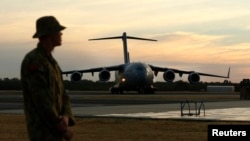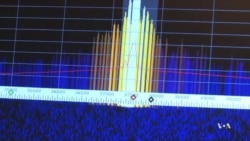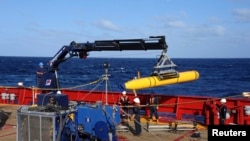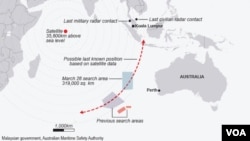BANGKOK —
Nearly three weeks after the ill-fated Malaysian jet, MH370, disappeared off radar, Australian authorities say new analysis of in flight satellite data has led them to move the search area some 1,100 kilometers to the northeast in the Indian Ocean. Australian search planes have spotted objects in area.
Australian authorities say the international team analyzing the data sent by the Boeing 777 in mid flight found that the plane was traveling faster than previously estimated and so likely ran out of fuel sooner.
As a result, authorities decided to abandon the area that planes and ships had been methodically searching for days.
“The Australian authorities have indicated that they have shifted the search area approximately 1,100 kilometers to the northeast," Malaysian Defense Minister Hishamuddin Hussein told reporters in Kuala Lumpur. "Because of ocean drift, this new search area could still be consistent with the potential objects identified by various satellites images over the past week.”
Debris spotted
Several satellites have spotted debris floating on the open ocean that may have been from the flight, but so far searchers have not recovered any physical evidence of the plane.
Martin Dolan, Chief Commissioner of the Australian Transport Safety Bureau, said while the new information represents a "credible lead” in the search for the missing aircraft, he remains cautious.
"The information provided by the international investigative team is the most credible lead we currently have in the search for aircraft wreckage. However, this information needs to be continually adjusted for the length of time elapsed as the aircraft went missing and the likely drift of any wreckage floating on the ocean surface," Dolan said.
Mysterious disappearance
It is still unknown why the Boeing 777 aircraft, on a routine flight from Kuala Lumpur to Beijing on March 8, with 239 passengers and crew on-board, veered west after its flight transponder stopped transmitting.
The new analysis places a possible crash site in a region of some 319,000 square kilometers. The location is closer to Perth, where search planes are based, meaning they should be able to spend more time combing the search area instead of traveling to and from it.
John Young, a manager with the Australian Maritime Safety Authority, says the new area will hopefully have better weather conditions.
"I'm not sure that we'll get perfect weather out there but it's likely to be better more often than we have seen in the past and we see what that does in terms of satellite imagery when the re-tasking of satellites starts to produce new material," Young said.
Australia's Geospatial-Intelligence Organization (AGO) is to re-task satellites to capture images of the new area.
After search efforts were hampered by poor weather a day earlier, 10 aircraft from Australia, China, Japan, South Korea, New Zealand, and the United States were covering the new region on Friday.
Vessels from several of the search nations' navies have also been scouring the seas in the hope of uncovering identifiable debris.
Payouts begin
Although no wreckage has yet been found, echoing comments from Malaysia that the plane had definitely crashed and there was no hope of survivors being found, Chinese insurance companies started to pay compensation to the families of passengers aboard the plane.
China Life, the country's largest insurance company, has provided the families of seven passengers with a total compensation of 4.17 million yuan ($671,600), Chen Honghao, an official from China Life's department of planning, told Reuters by telephone on Friday.
Other insurers, including China Pacific, Sunshine Insurance and New China Life have also begun to pay out claims, representative from those companies confirmed.
Some information in this report contributed by Reuters.
Australian authorities say the international team analyzing the data sent by the Boeing 777 in mid flight found that the plane was traveling faster than previously estimated and so likely ran out of fuel sooner.
As a result, authorities decided to abandon the area that planes and ships had been methodically searching for days.
“The Australian authorities have indicated that they have shifted the search area approximately 1,100 kilometers to the northeast," Malaysian Defense Minister Hishamuddin Hussein told reporters in Kuala Lumpur. "Because of ocean drift, this new search area could still be consistent with the potential objects identified by various satellites images over the past week.”
Debris spotted
Several satellites have spotted debris floating on the open ocean that may have been from the flight, but so far searchers have not recovered any physical evidence of the plane.
Martin Dolan, Chief Commissioner of the Australian Transport Safety Bureau, said while the new information represents a "credible lead” in the search for the missing aircraft, he remains cautious.
"The information provided by the international investigative team is the most credible lead we currently have in the search for aircraft wreckage. However, this information needs to be continually adjusted for the length of time elapsed as the aircraft went missing and the likely drift of any wreckage floating on the ocean surface," Dolan said.
Mysterious disappearance
It is still unknown why the Boeing 777 aircraft, on a routine flight from Kuala Lumpur to Beijing on March 8, with 239 passengers and crew on-board, veered west after its flight transponder stopped transmitting.
The new analysis places a possible crash site in a region of some 319,000 square kilometers. The location is closer to Perth, where search planes are based, meaning they should be able to spend more time combing the search area instead of traveling to and from it.
John Young, a manager with the Australian Maritime Safety Authority, says the new area will hopefully have better weather conditions.
"I'm not sure that we'll get perfect weather out there but it's likely to be better more often than we have seen in the past and we see what that does in terms of satellite imagery when the re-tasking of satellites starts to produce new material," Young said.
Australia's Geospatial-Intelligence Organization (AGO) is to re-task satellites to capture images of the new area.
After search efforts were hampered by poor weather a day earlier, 10 aircraft from Australia, China, Japan, South Korea, New Zealand, and the United States were covering the new region on Friday.
Vessels from several of the search nations' navies have also been scouring the seas in the hope of uncovering identifiable debris.
Payouts begin
Although no wreckage has yet been found, echoing comments from Malaysia that the plane had definitely crashed and there was no hope of survivors being found, Chinese insurance companies started to pay compensation to the families of passengers aboard the plane.
China Life, the country's largest insurance company, has provided the families of seven passengers with a total compensation of 4.17 million yuan ($671,600), Chen Honghao, an official from China Life's department of planning, told Reuters by telephone on Friday.
Other insurers, including China Pacific, Sunshine Insurance and New China Life have also begun to pay out claims, representative from those companies confirmed.
Some information in this report contributed by Reuters.














